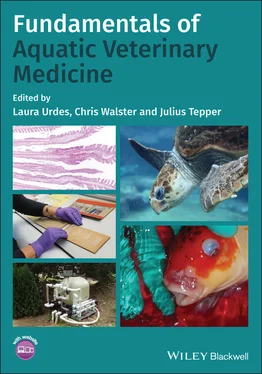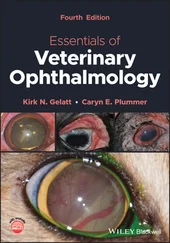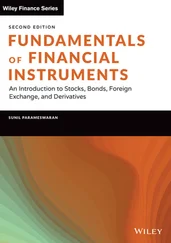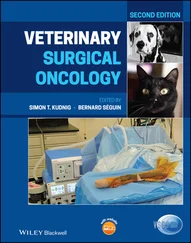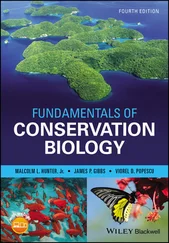Fundamentals of Aquatic Veterinary Medicine
Здесь есть возможность читать онлайн «Fundamentals of Aquatic Veterinary Medicine» — ознакомительный отрывок электронной книги совершенно бесплатно, а после прочтения отрывка купить полную версию. В некоторых случаях можно слушать аудио, скачать через торрент в формате fb2 и присутствует краткое содержание. Жанр: unrecognised, на английском языке. Описание произведения, (предисловие) а так же отзывы посетителей доступны на портале библиотеки ЛибКат.
- Название:Fundamentals of Aquatic Veterinary Medicine
- Автор:
- Жанр:
- Год:неизвестен
- ISBN:нет данных
- Рейтинг книги:4 / 5. Голосов: 1
-
Избранное:Добавить в избранное
- Отзывы:
-
Ваша оценка:
- 80
- 1
- 2
- 3
- 4
- 5
Fundamentals of Aquatic Veterinary Medicine: краткое содержание, описание и аннотация
Предлагаем к чтению аннотацию, описание, краткое содержание или предисловие (зависит от того, что написал сам автор книги «Fundamentals of Aquatic Veterinary Medicine»). Если вы не нашли необходимую информацию о книге — напишите в комментариях, мы постараемся отыскать её.
Covers the competencies necessary to assure the highest quality of aquatic veterinary services Fundamentals of Aquatic Veterinary Medicine
Fundamentals of Aquatic Veterinary Medicine — читать онлайн ознакомительный отрывок
Ниже представлен текст книги, разбитый по страницам. Система сохранения места последней прочитанной страницы, позволяет с удобством читать онлайн бесплатно книгу «Fundamentals of Aquatic Veterinary Medicine», без необходимости каждый раз заново искать на чём Вы остановились. Поставьте закладку, и сможете в любой момент перейти на страницу, на которой закончили чтение.
Интервал:
Закладка:
Other factors that may impact the dose requirements for pathogen inactivation in a system are the bacterial repair mechanisms – photoreactivation and dark repair – that may allow bacteria to resist being killed by repairing the UV damage. Preventing exposure of the water to natural light will help to inhibit photoreactivation of bacteria in the system, as will increasing the UV dose in the system beyond the standard published doses. Preventing reduction of lamp intensity, which can occur with poor water quality or increased flow, will also help to reduce photoreactivation in the system. In cold‐water aquaculture with short water retention times, photoreactivation is more likely to become a problem than dark repair. Likewise, in recirculating systems that have long water retention times (many cycles of the same water or a high reuse percentage with very few additions of new water) dark repair may be more of a concern. UV filtration at lower doses is often employed in aquasystems for planktonic algae control (using a UV light unit).
1.3.1.3 Ozone Filtration
Another type of water treatment that can be used is ozone. This effective oxidizer is produced in an onsite system and requires a high voltage generation unit. It is usually reserved for larger industrial aquasystems and public aquaria. A large source of purified oxygen is required to produce the ozone, which can be linked to a low head oxygenator or other oxygen feed systems that may already be in use to increase production capacity of a facility. Ozone oxidizes cell membranes, making it effective at killing bacteria, but fish and humans should not be directly exposed to it. As with UV, contact time in the water is important, with considerations for an initial killing dose followed by a residual dose to meet the required contact time. The residual dose can be reached inside a residual holding tank, allowing for longer contact time. The ozone must be transferred to the water by some method of injection system and inactivated before reaching the fish holding tanks, as fish are highly sensitive to residual ozone. When used in seawater systems, additional byproducts may need to be managed.
1.3.1.4 Biological Filtration
The conversion of ammonia to nitrite and nitrate is critically important in aquasystems where new water exchange is minimal. These systems must be treated with care to ensure that adequate levels of beneficial bacteria are maintained to perform this conversion. In cases of high recirculating water reuse systems that recirculate water in the 90% range, a dedicated biofilter is used before the water reenters the main system. In the biofilter, the conversion is accomplished through the use of specialized media designed to maximize bacterial performance.
Features of a biofilter that impact its capacity to convert ammonia through to nitrate in any aquasystem are the type of media used and the surface area per unit volume for bacterial growth, as well as the water flow pattern, degree of oxygen exchange and adequacy of sediment removal. Most biofilters use plastic composite material, although older systems may employ lava rock. Sand can also be used in upflow‐designed tanks, called fluidized bed bioreactors, after the water has been cleared of settleable solids. Many types of biological filters that use varying technologies are already in use in recirculating aquaculture. This field is rapidly growing and expanding. With increasing popularity and utility of recirculating systems, the capabilities of these units continue to improve and it is important that a system is designed to allow for upgrades and improvements. While biofiltration conserves water and increases production capacities, these filters require substantial floor space and add a high cost to initial system installation. In selecting this type of system, the long‐term benefits such as water usage savings, increases in production capacity, and decreased effluent discharge should be weighed against the initial cost. The details of biofilters are complex. Additional information can be found in specialized texts such as Recirculating Aquacultur e by Timmons et al . (2018). Further study is recommended prior to working with these types of complex systems.
1.3.2 Aquasystem Water
1.3.2.1 Abiotic (Chemical and Physical) Properties
Oceans, rivers, lakes, and even ponds, are various types of aquatic ecosystems. The abiotic components of aquatic ecosystems are the physical and/or chemical factors characteristic of the environment that act on the living organisms during any part of their life. These abiotic factors are also called ecological factors. They vary from ecosystem to ecosystem; for example, the abiotic factors in the marine biome differ from those of fresh water in terms of chemistry, light, current and temperature.
Some of the chemicophysical parameters of water have a direct influence on fish health. Any abrupt and wider than normal fluctuations of such values cause a state of stress in fish, sometimes resulting in widespread disease outbreaks. Dissolved oxygen content, pH, turbidity, temperature, introduction of some chemicals, detergents, pesticides and naturally produced toxic products like hydrogen sulfide, ammonia, dinoflagellate toxins are potential stress‐related parameters.
1.3.2.2 Temperature
Fish are ectotherms, which means that they do not regulate their body temperature internally so it fluctuates with external environmental changes. Sudden change often causes stress and sometimes even death in extreme situations. Temperature affects the development and growth of fish more than any other single factor and also influences other variables. Metabolic rate either increases or decreases two‐fold for every 8°C. Each species has an optimal temperature range for growth and reproduction. Cultured species should be selected according to the prevailing water temperature in each locality. This is because the temperature range at which an organism can survive depends on their temperature adaptation pattern over time.
Water temperature greatly influences water quality, because the growth and metabolism of phytoplankton, bacteria and other microorganisms increases with increasing temperature. Moreover, water holds less oxygen at higher temperatures. Dissolved oxygen depletion is much more likely to occur during hot weather than during cooler periods. Rates of chemical processes such as ionization, mineral dissolution, adsorption and ion exchange also increase in response to higher water temperature. The onset of potentially harmful water quality events is faster in warmer weather. A deep pond can also be subject to thermal stratification, with large temperature fluctuations among layers of the water column.
Warm‐water species grow best above 21°C
Cold‐water species grow best below 21°C
Cool‐water species grow best at mid‐range from 21°C to 28°C
Sudden temperature changes cause stress and even death.
1.3.2.3 pH
The term “pH” is a mathematical transformation of the hydrogen ion (H +) concentration; it conveniently expresses the acidity or basicity of water. The lowercase letter “p” refers to “power” or exponent, and pH is defined as the negative logarithm of the hydrogen ion concentration. Each change of one pH unit represents a 10‐fold change in hydrogen ion concentration. The pH scale is usually represented as ranging from 0 to 14, where lower number reflects higher acidity and the higher number reflects higher alkalinity. Water with a pH of 4.5 or lower has no measurable alkalinity. Water with a pH of 8.3 or higher has no measurable acidity. At 25°C, a pH value of 7 is neutral; this describes the neutral point of water at which the concentrations of hydrogen and hydroxyl ions (OH –) are equal (each at 10–7 moles/l). The pH of freshwater ecosystems can fluctuate considerably within daily and seasonal timeframes, and most freshwater animals have evolved to tolerate a relatively wide environmental pH range. Animals can, however, become stressed or die when exposed to pH extremes or when pH changes rapidly, even if the change occurs within a pH range that is normally tolerated. The pH of water in ponds often increases during the day and decreases at night. Fish and other vertebrates have an average blood pH of 7.4. Recommended pH range for cultured fish is 6.5–9.0. Acid death point is around 4; alkaline death point is around 11. The hydrogen ion concentration affects aqueous equilibria involving ammonia, hydrogen sulfide, chlorine and dissolved metals. Interactions of pH with these variables are often more important than the direct effects of pH on aquatic animals. For example, the toxicity of ammonia to fish increases with an increase in pH. Chemical interactions among carbon dioxide, hydrogen ions and the anions that produce alkalinity buffer the pH of most natural waters in a range of about 6–8.5.
Читать дальшеИнтервал:
Закладка:
Похожие книги на «Fundamentals of Aquatic Veterinary Medicine»
Представляем Вашему вниманию похожие книги на «Fundamentals of Aquatic Veterinary Medicine» списком для выбора. Мы отобрали схожую по названию и смыслу литературу в надежде предоставить читателям больше вариантов отыскать новые, интересные, ещё непрочитанные произведения.
Обсуждение, отзывы о книге «Fundamentals of Aquatic Veterinary Medicine» и просто собственные мнения читателей. Оставьте ваши комментарии, напишите, что Вы думаете о произведении, его смысле или главных героях. Укажите что конкретно понравилось, а что нет, и почему Вы так считаете.
